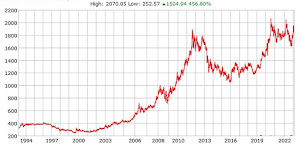Fake gold
Fake gold, also known as counterfeit or imitation gold,
refers to any material that is made to resemble gold but does not contain
genuine gold. There are various ways in which fake gold can be created, and
it's important for consumers to be aware of these methods to avoid being
deceived. Some common methods of creating fake gold include
Gold Plating A thin
layer of gold is applied to the surface of another metal. While it may look
like gold initially, the thin layer can wear off over time.
Gold-filled or Gold-overlay: These terms are used when a
thicker layer of gold is applied to a base metal. However, it's still not solid
gold, and the base metal may be visible over time.
Gold Vermeil This is a layer of gold plated over sterling
silver. It's more durable than regular gold plating but is not solid gold.
Gold Paint or Gold Leaf: Some items may be coated with a
gold-colored paint or leaf to give the appearance of gold.
Gold-Plated Tungsten or Brass: Some jewelry or items may be
made from metals like tungsten or brass and then coated with a thin layer of
gold.
Distinguishing real gold from fake gold involves various methods, and it's important to note that professional testing is the most reliable approach. Here are some common ways people use to differentiate between real and fake gold:
Hallmarks and Stamps:
- Real gold jewelry often carries markings, or hallmarks, indicating its purity. Common hallmarks include "24K" for pure gold, "18K" for 18 karat gold, and so on.
- Check for manufacturer stamps and country of origin marks.
Magnet Test:
- Gold is not magnetic, so if a piece of jewelry is attracted to a magnet, it is likely not real gold.
- Note that this is not foolproof, as some fake gold alloys may also be non-magnetic.
Color and Appearance:
- Real gold maintains a consistent color and does not tarnish. If you observe discoloration or signs of fading, it might not be genuine.
- Genuine gold has a distinct, warm color that is not easily replicated by other metals.
Density Test:
- Gold is a dense metal, so it should feel heavy for its size. If a piece that appears to be gold feels light, it may be fake or only gold-plated.
Scratch Test:
- Gold is a soft metal, and you can perform a scratch test using a small file. If the material easily scratches, it's likely not real gold.
- However, this method is not recommended for valuable jewelry, as it damages the piece.
Acid Test:
- This involves applying nitric acid to a small scratch on the item. Real gold will not react or discolor, but fake gold might change color.
- This test can damage the jewelry and should be performed cautiously or by a professional.
Specific Gravity Test:
- Comparing the weight of the object in air to its weight in water can help determine its density, which can be used to identify the material.
Professional Appraisal:
- If in doubt, seek the expertise of a professional appraiser or jeweler. They have specialized tools and knowledge to accurately assess the authenticity of gold items.
It's important to note that fake gold can take various forms, such as gold-plated items, gold-filled items, or alloys that imitate the appearance of gold. Professional testing is always recommended, especially for high-value items.
To avoid purchasing fake gold, it's essential to buy from
reputable and trustworthy sources. Consider getting jewelry and precious metal
items tested or certified by professionals before making a purchase, especially
if dealing with high-value items. Additionally, be cautious when buying from
unfamiliar sellers or if the price seems too good to be true.
However, I can provide some general information about what is typically considered "pure" gold:
- Pure gold is referred to as 24 karat (24K) gold. This means the metal contains 99.9% gold by mass and only trace amounts of other elements.
- Pure 24K gold has a bright yellowish metallic luster and is extremely soft and malleable compared to alloys.
- It is very rare to find refined gold that is literally 100% pure, as even minuscule amounts of other metals like silver, copper, etc. are difficult to remove completely.
- More commonly, you'll find gold described by different karat numbers like 22K (91.6% pure), 18K (75% pure), 14K (58.3% pure) etc. These are gold alloys mixed with other metals to increase strength and hardness.
- Pure 24K gold is generally considered too soft for many practical applications, so it is often alloyed with small amounts of metals like copper, silver, nickel, zinc etc.
So in summary, if the material you have is a vibrant yellow color, very soft, and has been verified as 24 karat through testing or documentation from a refiner, then it can reasonably be considered basically 100% pure gold within technical/analytical limits. Anything less than 24K contains intentional alloy mixtures. Let me know if you need any other clarification!
Your like, share and subscribe is my motivating
thank you very much














0 ความคิดเห็น: